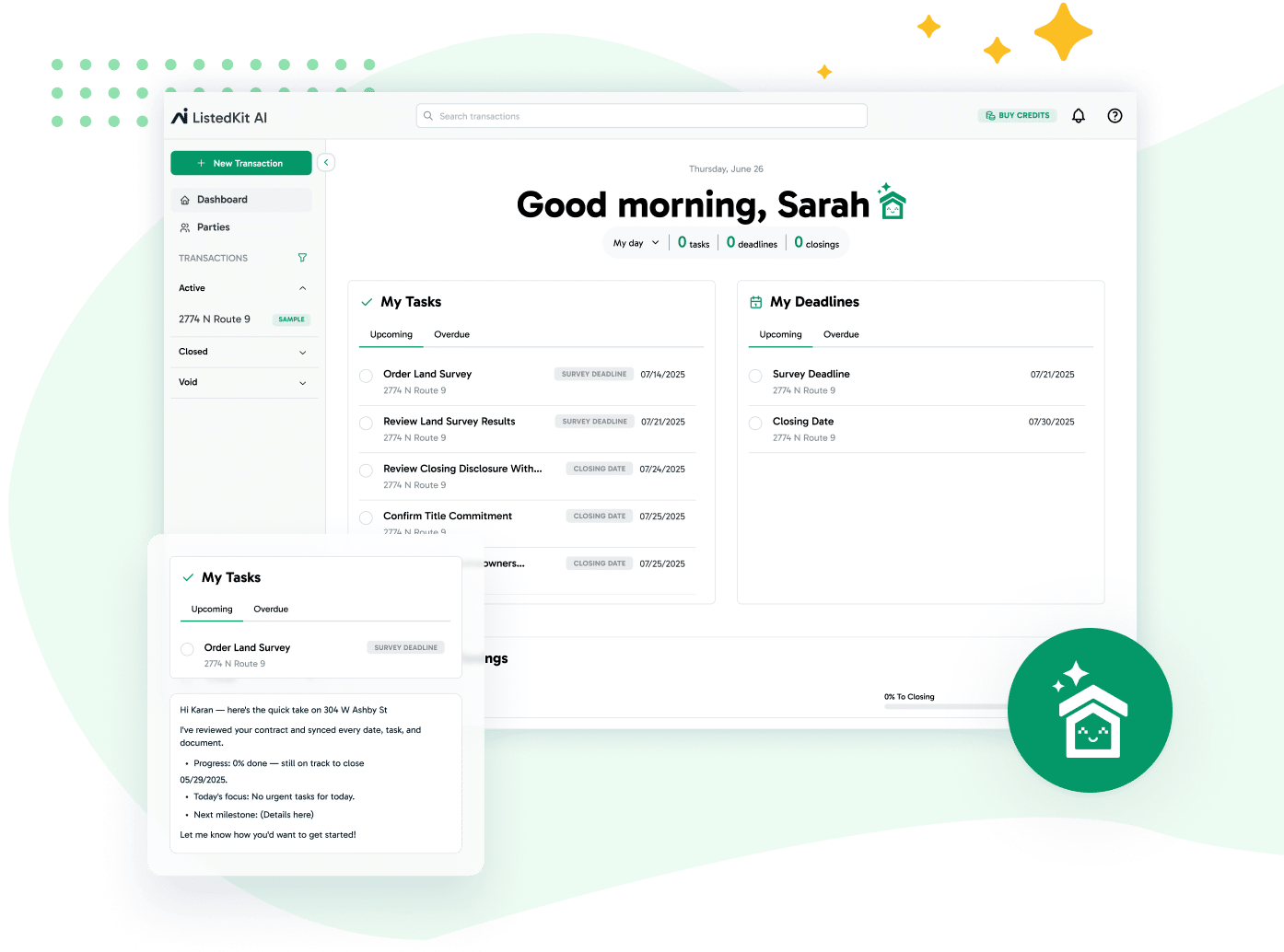As a transaction coordinator you are the behind-the-scenes hero of every real estate deal. Your ability to manage and organize important documents makes the process smoother and better for the client. Document management is the key to a smooth and professional transaction.
By having a system to manage contracts, disclosures and other important paperwork, you make the client feel safe and informed. This level of organization and accessibility is what sets you apart. You’re not just managing files. You’re enhancing the client experience.
In this article, we’ll go over how you can improve your document management so every transaction is handled with precision and care. Whether you’re a seasoned coordinator or new to the role mastering these practices will help you have a clear and accessible paper trail.
Document Management in Real Estate
Managing the documentation process means making sure every paper is filed and easily found. This includes contracts, inspection reports and other important documents.
As the coordinator, you also have to manage tasks like tracking contingency removals and making sure all brokerage-specific forms and smart forms are completed and filed correctly. Good document management can save administrative costs and speed up the closing process.
Paper Trail for Legal and Professional Purposes
A paper trail is the chronological record of all transactions and communications for a real estate deal. This includes contracts, mortgage documents and due diligence checklists that need to be filed and stored. Having a complete paper trail is for legal and professional purposes and to have all documents in order.
During the contingency period, a paper trail is even more important. It’s managing documents for contingency removals and standard contingencies.
A good document system not only helps with auditing and compliance but also provides a transparent record of all changes and updates during the transaction process.
For instance, with ListedKit, all documents are available to clients and agents at any time. This means a smoother real estate experience peace of mind and clarity throughout the transaction.
Step 1: Set up your Document System
Setting up a document system is key for real estate transaction coordinators. By having your folders in order and the right tools you can get to all documents quickly.
One Place for All Documents
Having one place for all documents simplifies your workflow. Reduces time spent searching through a document mess. Instant access to these documents means you can respond to client or agent queries faster.
Having documents means you can get to them when you need to. This is important for transparency and compliance in all transactions. Most importantly, peace of mind means knowing everything is in one place.
Folders by Transaction, Client and Document
Folding by transaction, client, and document type is key to clarity. Start by creating a main folder for each transaction. Within this transaction folder, create subfolders for each client.
Break these subfolders down into specific document types like purchase agreements, deeds and inspection reports. This way, you can find any document fast and save time.
How ListedKit Can Help
ListedKit is a simple way to store and manage documents. Clients and agents have access to files through their portals.
This means you can manage documents better, with less manual work and more productivity. Using ListedKit means smooth transactions and document management.
Example Folders to Access and Organize
A good folder structure means easy access and organization. Start with a main folder named after the property address or transaction ID.
Inside, create subfolders:
- Client Documents (personal details and agreements)
- Transaction Documents (contracts, inspection reports, etc.)
- Financial Documents (mortgage statement, payment receipts)
- Legal Documents (disclosure statements, compliance certificates)
- Communication Records (emails and correspondence, meeting notes, log calls)
Each subfolder should have specific document types. This way, you can find any document and not lose it in a mess.
By doing this, you have a consistent and streamlined workflow.
Step 2: Setting up Access Controls
Setting up access controls is key for transaction coordinators in real estate to secure documents and comply. Clear permissions help manage the flow of forms and sensitive info.
Best Practices for Accessing Sensitive Documents
First, you must define who can access specific documents. Role-based access control (RBAC) is a good practice. This means assigning permissions based on user roles like agents, clients or admins. For example, agents can access transaction details while clients can only view documents related to their transactions.
Digital access instead of physical files means tracking and auditing document access is easier. Tools like ListedKit allow clients and agents to access documents through their portal anytime. This is not only more accessible but more secure.
Regular audits and reviews of permissions ensure that only authorized people have access to sensitive documents. Keeping a log of access and changes means transparency and helps with additional review permissions.
Permissions and Sharing Protocols
Permissions must be set up correctly. Start by categorizing your documents by sensitivity. Publicly accessible files should never have sensitive info. Use layered security protocols to protect more sensitive documents. For example, encrypt documents with personal or financial info.
When sharing documents use secure sharing protocols. Never use email to share. Instead, use secure platforms that have encryption and authentication. Secure digital platforms like ListedKit help manage and secure document access.
Set up protocols for sharing that require authorization before accessing or distributing sensitive documents. This prevents unauthorized sharing, and all actions are logged and monitored. Update these protocols regularly to accommodate new compliance requirements and security threats.
Step 3: Document Consistency and Accuracy
Your documents must be consistent and accurate for smooth transactions. This means clear naming conventions, no multiple versions, and strict guidelines.
Naming Guidelines for Consistent and Descriptive Documents
Naming consistent and descriptive documents is key. It helps you find files fast and reduce errors. Use a standard format for naming documents, for example, “PropertyAddress_DocumentType_Date”. Include keywords like property address and document type to save time.
Don’t use vague names like “Document1” or “Scan”. Be specific and make sure everyone in your team follows the same format. This makes it easier for you and your clients to access documents through ListedKit.
Using keywords related to the specific transaction, such as the property address or client name, can also help with the clarity and searchability of your files. This way documents can be quickly identified and retrieved, reducing time spent searching for important info.
For example, instead of naming a file as something generic like ‘Contract’, you could name it ‘Smith_123OakAve_Contract_20240715.pdf’. This way, the client’s last name, property address, document type, and date are clearly indicated.
Examples of Document Naming Conventions
Using clear naming conventions helps you manage different types of documents. Here are some examples:
- Purchase Agreement: 123MainSt_PurchaseAgreement_20240730.pdf
- Inspection Report: 123MainSt_InspectionReport_20240728.pdf
- Deed of Sale: 123MainSt_Deed_20240725.pdf
These formats keep important documents organized and easy to find. Keep your document names short, consistent and meaningful. This way, you and your clients can find what you need without hassle.
How to Avoid Confusion with Multiple Document Versions
Managing multiple versions of a document is tricky. Always label each version clearly. Use terms like “Draft”, “Final”, or “Revised” followed by the date. For example, 123MainSt_PurchaseAgreement_Draft_20240701.pdf and 123MainSt_PurchaseAgreement_Final_20240715.pdf.
Communicate regularly with your team and clients to ensure everyone knows the latest version. When storing documents on online software, make sure the portal shows the most current version. This prevents mistakes and confirms everyone is working with the right document.
Or, if you feel the older versions are no longer needed, archive or securely delete them to declutter and avoid confusion. This will keep your system streamlined and organized and reduce the chance of using outdated info.
Step 4: Audits and Reviews
Audits and reviews keep your real estate documents accurate and up-to-date. This reduces risk and keeps your paperwork compliant with state laws and industry standards.
Why documents must be current
Documents must be current to avoid unreviewed documents that can cause errors. Transaction coordinators handle multiple types of documents like bankruptcy records, land records and other important papers. When documents are outdated, they are non-compliant and slow down transactions.
You can store documents per file to track revisions. Updating digital records regularly ensures everyone has the latest info and reduces the chance of using the wrong paperwork.
How to Audit Your Document Storage
Audit your document storage regularly. Create a schedule for audits—monthly, quarterly or annually. Focus on checking the accuracy and completeness of your key files, like contracts and compliance documents.
By having detailed audit trails, you can see who accessed or modified documents. Make sure all scanned copies of paper records are clear and legible. Digital storage makes it easier, and you can correct a file if found outdated or incomplete.
Checklist to Ensure All Documents are Up-To-Date and Filed Properly
A checklist is important for record keeping. Make sure each document has:
- Clear titles.
- Correct categorization.
- Proper naming convention (e.g. 123_MainSt_JohnDoe_Contract.pdf).
- Versions and revisions tracked.
Check if no papers are missing. Cross-check that all entries—client info, transaction details, and legal requirements—are complete and accurate. Use tools to flag files that need to be updated or have revisions pending.
By following this checklist regularly, you can have an organized, compliant and efficient document management system and reduce the risk of errors and omissions.
Software to Optimize Management
To have smooth document management for transaction coordinators, using software tools can make a big difference. Using these tools streamlines workflows saves time and improves accuracy.
For example, ListedKit is cloud-based real estate software for transaction coordinators that simplifies document management. Its features allow users to access, edit, and store documents in one place.
How to Set These Up to Your Workflow
Customization is key to getting the most out of any estate transaction management software. With ListedKit, you can customize features to fit your needs. Start by setting up templates for frequently used documents to save time on repetitive tasks.
Auto-populating fields can be set up to pull information from existing databases or forms to ensure data consistency across all documents. By setting these up, your workflow will be more streamlined, there will be fewer bottlenecks, and you will be more productive.
And integration with other tools will take it to the next level. This will consolidate all the functions in one system and make it simpler. Configuring will not only make you more efficient but also standardize the way you handle documents.
Conclusion
Document management is key for transaction coordinators to run their process smoothly and make clients happy. Follow these best practices, and you’ll be organized and transparent. Remember to:
- Create a Central Hub: Start by creating one place to store all transaction documents. This will keep files organized and information readily available.
- Implement Strong Access Controls: Protect sensitive info by setting clear access permissions. Assign these permissions based on roles and review them periodically. This will protect documents and build trust with clients.
- Consistency and Accuracy in Documents: Use the same naming and categorization for documents. This makes it easier to retrieve and minimizes mistakes or miscommunication. Review and update these regularly to keep them working.
- Audit and Review Regularly: Check and update your document system regularly to keep it current and compliant with laws. This will keep all documents up to date.
This will make you more efficient and your clients and team happy. Document management is the foundation of smooth, professional and transparent real estate transactions, and it’s key to your success as a transaction coordinator.
You can also use software like ListedKit. It has a central hub where all documents can be stored, accessed and managed. Plus you can use it to streamline your workflow, set up email templates and auto-populate fields to save time and reduce errors.




